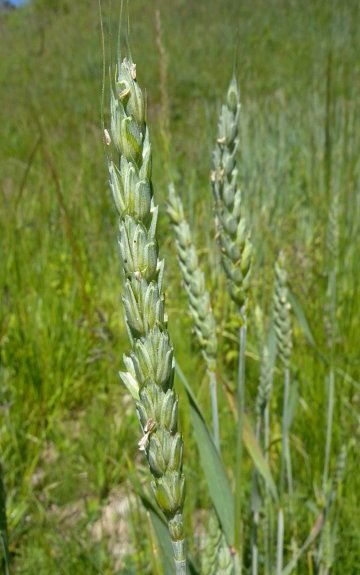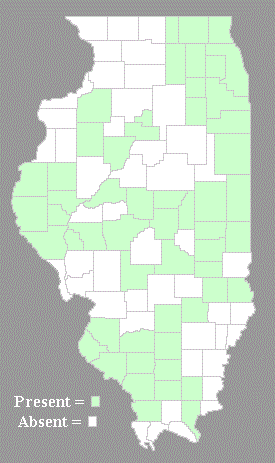
Each spikelet is 10-15 mm. in length, consisting of a pair of glumes at the bottom and 2-5 florets with lemmas above. The glumes are 9-11 mm. in length, ovate in shape, partially keeled, and glabrous. The lemmas are 10-13 mm. in length, ovate in shape, convex along their outer surfaces, and glabrous. Along the inner sides of the florets, are membranous paleas that are similar in size to the lemmas. At the apices of the glumes and lemmas, there are 1-2 small teeth. In some varieties of wheat, the glumes can have awns up to 30 mm. long, while the lemmas can have awns up to 80 mm. long. These awns are erect. Each floret consists of an ovary, a pair of feathery stigmata, and stamens. The blooming period usually occurs from late spring to mid-summer. The florets are cross-pollinated by the wind. They are replaced by grains that are 7.5-8.5 mm. long, 3.5-3.75 mm. across, and ovoid-ellipsoid in shape; the light-colored grains are convex on one side and incurved on the other side. The root system is fibrous.
Cultivation: The preference is full sun, mesic to dry-mesic conditions, and soil containing loam or clay-loam. Some varieties of wheat (winter wheat) are planted during the fall, while other varieties (spring wheat) are planted during the spring.

Range & Habitat: Naturalized plants of non-native Wheat are occasional throughout Illinois. Wheat originated from the eastern Mediterranean or the Middle East in Eurasia. It is a major agricultural crop. Occasionally, Wheat escapes from cultivation and self-sows. However, such escaped plants do not persist in the environment for very long. Typical habitats of such plants include fields, roadsides, areas along railroads, areas near grain elevators, and open waste areas. Sometimes Wheat is deliberately planted as a source of food for wildlife and to control erosion along roadside embankments until perennial grasses become established. Wheat thrives in highly disturbed areas with exposed topsoil.
Faunal Associations: Wheat attracts various insects that feed on the foliage, grains, roots, or plant juices. These insects include Chaetocnema denticulata (Toothed Flea Beetle), Diabrotica barberi (Northern Corn Rootworm), Myochrous denticollis (Southern Corn Leaf Beetle), and Oulema melanopus (Cereal Leaf Beetle); Sphenophorus callosus (Southern Corn Billbug), Sphenophorus destructor (Destructive Billbug), Sphenophorus minimum (Little Billbug), Sphenophorus parvulus (Bluegrass Billbug), and Sphenophorus venatus venatus (Hunting Billbug); Macrosiphum avenae (English Grain Aphid), Rhopalosiphum padi (Bird Cherry Oat Aphid), Schizaphis graminum (Greenbug), and Sipha flava (Yellow Sugar Cane Aphid); Euschistus servus (Brown Stink Bug), Euschistus variolarius (One-Spotted Stink Bug), and Oebalus pugnax pugnax (Rice Stink Bug); the shield bug Homaemus bijugis; Camnula pellucida (Clear-Winged Grasshopper), Dissosteira carolina (Carolina Grasshopper), Melanoplus femurrubrum (Reg-Legged Grasshopper), and Melanoplus sanguinipes (Migratory Grasshopper); and the caterpillars or cutworms of such moths as Achatodes zeae (Elder Shoot Borer Moth), Apamea amputatrix (Yellow-Headed Cutworm), Apamea finitima (Bordered Apamaea), Dargida diffusa (Wheathead Armyworm), Leucania pseudargyria (False Wainscot), Ochsenheimeria vacculella (Cereal Stem Moth), Peridroma saucia (Variegated Cutworm), and Rachiplusia ou (Gray Looper). A large number of geese, ducks, upland gamebirds, and granivorous songbirds eat the grains of Wheat (see the Bird Table for a listing of these species); this consists primarily of grains that have been left on the ground after harvest time. In addition, migrating geese often eat the young foliage of winter wheat along the Mississippi flyway during the spring. Among mammals, the grains are eaten by the Eastern Skunk, Spotted Skunk, Fox Squirrel, Eastern Chipmunk, Thirteen-Lined Ground Squirrel, House Mouse, Deer Mouse, and White-Footed Mouse. The Cottontail Rabbit and White-Tailed Deer sometimes browse on the young foliage. The young foliage can also be used as pasturage for cattle, horses, sheep, and other domesticated animals.

Photographic Location: A waste area near a highway overpass and railroad at the National Dunes Lakeshore in NW Indiana. The photographed plants are a nearly awnless variety of Wheat.
Comments: This is the wheat that is used to make bread, pastry, and other food products. The grains are also used in making alcoholic beverages, industrial alcohol, and livestock feed. The old stems of wheat, or straw, is used as packing material, cattle bedding, mulch for gardens, and paper manufacturing. Because there are many varieties and subspecies of Wheat (Triticum aestivum), local populations of plants can vary somewhat in appearance. In particular, some varieties and subspecies of Wheat have abundant awns (referred to as 'Bearded Wheat'), while other varieties and subspecies are largely lacking in such awns. Wheat has been cultivated for thousands of years, beginning in the Middle East and ancient Egypt. From there, it eventually spread to Europe, and the European colonists brought wheat with them to North America. The closest relatives of Wheat in Illinois are the so-called wheatgrasses (Agropyron spp.), which were assigned to the Triticum genus at one time.